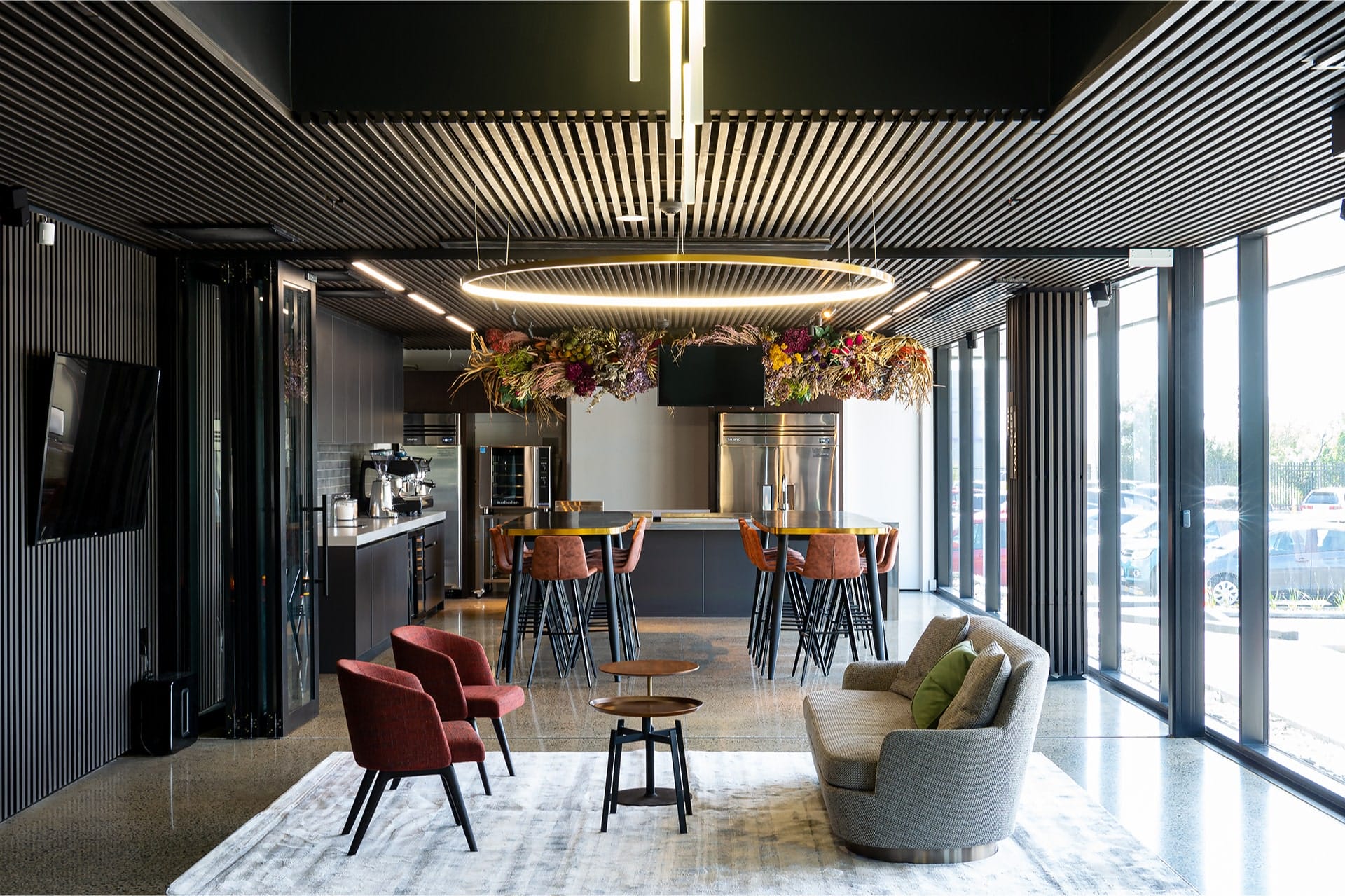

The Looks: How your workplace looks matters
At Spaceworks, our firsthand experiences have revealed the transformative power of workplace aesthetics on employee satisfaction, creativity, and overall business success. In this third edition of our series on key workplace design trends, we turn our attention to “The Looks”—unpacking how strategic design elements such as biophilic features, seamless indoor/outdoor connectivity, and the deliberate use of colour and materials can revolutionise work environments. All tools in the tool belt for creating spaces that inspire a productive workplace.
The following are images of the Service Foods fitout completed by Spaceworks.
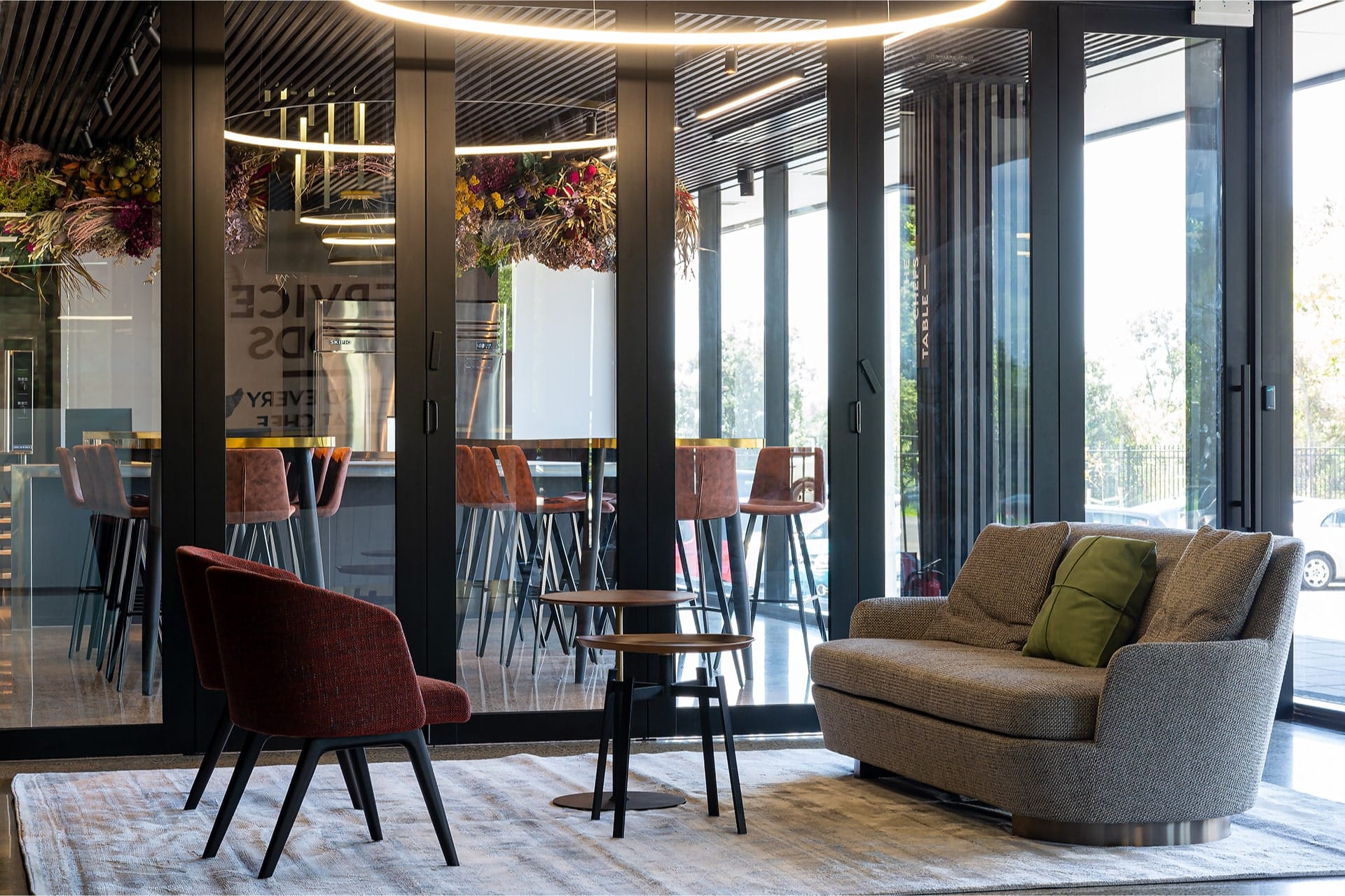
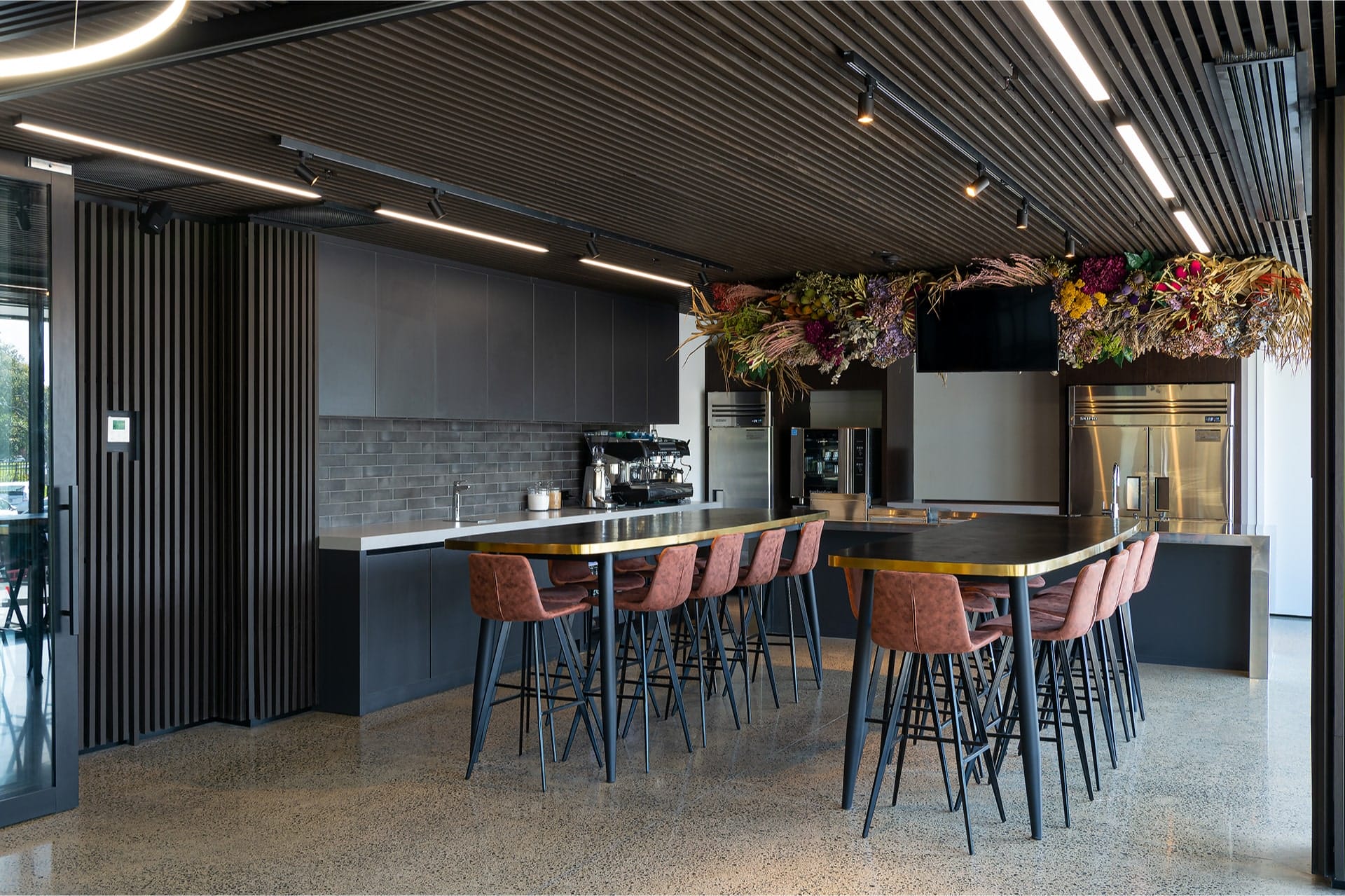
Aesthetics: Prioritising design to gain employee benefits
Aesthetics play an impactful role in workplace design, extending beyond mere visual appeal to significantly impact how employees feel and perform. A well-designed space can boost mood, enhance creativity, and make employees feel valued. From our extensive research and project experience, we’ve observed that a good-looking space not only makes people feel good but also instils a sense of pride and belonging among employees.
Aesthetics concentrate on visual appeal and helping users connect emotionally with their environment. Functionality, on the other hand, focuses on usability, practicality, and performance to ensure the space effectively fulfils its intended purpose. Office aesthetics are not just about creating a visually pleasing environment; they also influence how employees perceive the company’s values and culture. A thoughtfully designed office sends a message of care and investment in employees’ well-being, which in turn enhances job satisfaction and loyalty.
In a customer survey we conducted six years ago, the visual state of a workplace was directly linked to employees’ perceptions of how their employer valued them. Many reported that a tired and aged fit-out made them feel undervalued. Conversely, a fresh, modern design signalled that the business cared about their comfort and productivity, reflecting positively on their overall job satisfaction.
This concept connects back to our previous discussion on productivity. A well-designed office that looks good can boost employee engagement and efficiency, creating an environment where people want to perform at their best. This, in turn, influences how clients and customers perceive your business. An aesthetically pleasing and thoughtfully designed office demonstrates to clients that you value your business and, by extension, theirs.
Research supports the value of good design. According to a study by Hassell and Empirica, 75% of employees believe that the quality of their workplace environment affects their productivity and job satisfaction. Additionally, the Leesman Index reveals that workplaces with high aesthetic appeal can lead to a 25% increase in perceived productivity and engagement.
As organisations recognise that the workplace landscape is evolving, the emphasis is shifting from merely bringing people into the office to creating spaces that support their needs and adapt to changing demands. In 2024, businesses will continue to develop agile and flexible environments that are not only functional but also visually appealing enough to make employees look forward to coming to work.
By prioritising aesthetics in workplace design, businesses can create environments that enhance productivity, attract top talent, and foster employee retention, all while sending a strong message of care and investment in their workforce.
Biophilic Design: so much more than plants
As urbanisation continues to rise, with 70% of the world’s population expected to live in cities by 2050, the need to integrate nature into our daily environments becomes ever more critical. Biophilic design helps bridge the gap between urban living and our natural instincts, fostering healthier, more productive, and more satisfying workspaces.
Biophilic design celebrates our innate connection to nature, creating spaces that inspire, empower, and energise the people who use them. This approach to design leverages our deep-seated love of life and the natural world to foster environments that enhance well-being and productivity. Given the country many of us reside in, New Zealand, the attachment to nature is significantly high.
The concept of biophilia, popularised by biologist Edward O. Wilson in the 1980s, refers to humans’ inherent desire to connect with nature and other life forms. Biophilic design taps into this primal connection, incorporating natural elements into built environments to promote a sense of belonging and collaboration, a further integration with DE&I principles of belonging, the ultimate success of connection to a workplace and business.
Biophilia from a design perspective has often been thought of as the simple integration of plants but it goes further and deeper than this. It’s about the connection to natural elements. And we implore you not to take a white painted box and put plants on top of tambours, this is not biophilia used to its potential. When used well it’s integrated, it’s understood for its benefits and it’s a key ingredient to the design.
The benefits of biophilic design are extensive, impacting both physical and psychological health. Research suggests that exposure to natural elements can slow the heartbeat, reduce stress, and induce the production of hormones that foster feelings of well-being and community. Who doesn’t want this for themselves or their colleagues?
A study by Human Spaces indicated that incorporating biophilic elements into workplace design can improve productivity by 6% and creativity by up to 15%.
Having been avid knowledge seekers in the psychological and physiological benefits of design, biophilia extends to colour psychology as well. The ecological valence theory suggests that humans prefer nature-resembling colours like green and blue, which can create a calming and productive environment. Biophilic design is more than a design trend; it is an essential strategy for creating workplaces that support individuals to be their best selves holistically. This nurturing integration has a direct connection to reducing stress and boosting overall productivity and creativity.
This concept connects back to our previous discussion on productivity. A well-designed office that looks good can boost employee engagement and efficiency, creating an environment where people want to perform at their best. This, in turn, influences how clients and customers perceive your business. An aesthetically pleasing and thoughtfully designed office demonstrates to clients that you value your business and, by extension, theirs.
Research supports the value of good design. According to a study by Hassell and Empirica, 75% of employees believe that the quality of their workplace environment affects their productivity and job satisfaction. Additionally, the Leesman Index reveals that workplaces with high aesthetic appeal can lead to a 25% increase in perceived productivity and engagement.
As organisations recognise that the workplace landscape is evolving, the emphasis is shifting from merely bringing people into the office to creating spaces that support their needs and adapt to changing demands. In 2024, businesses will continue to develop agile and flexible environments that are not only functional but also visually appealing enough to make employees look forward to coming to work.
By prioritising aesthetics in workplace design, businesses can create environments that enhance productivity, attract top talent, and foster employee retention, all while sending a strong message of care and investment in their workforce.
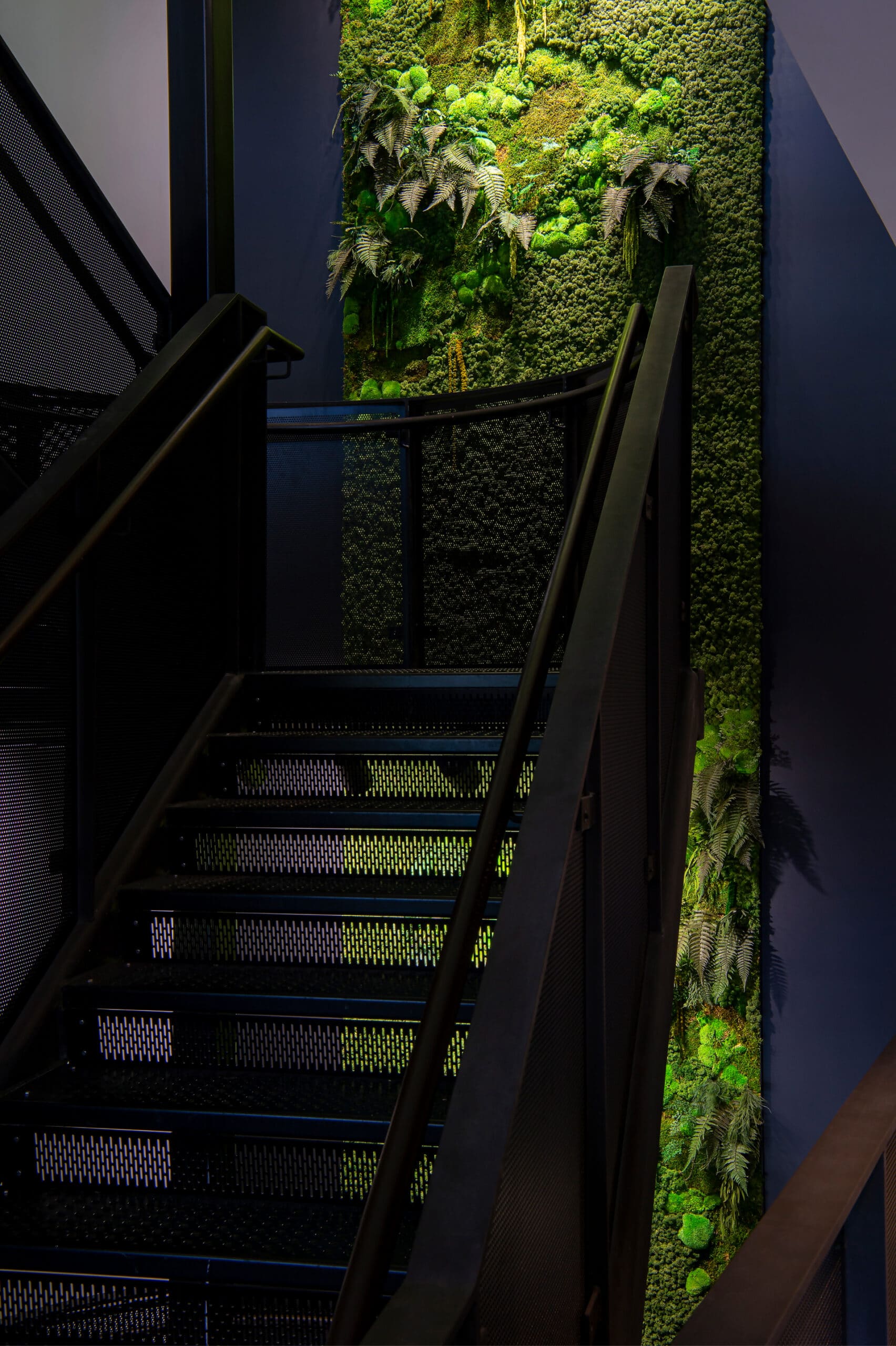
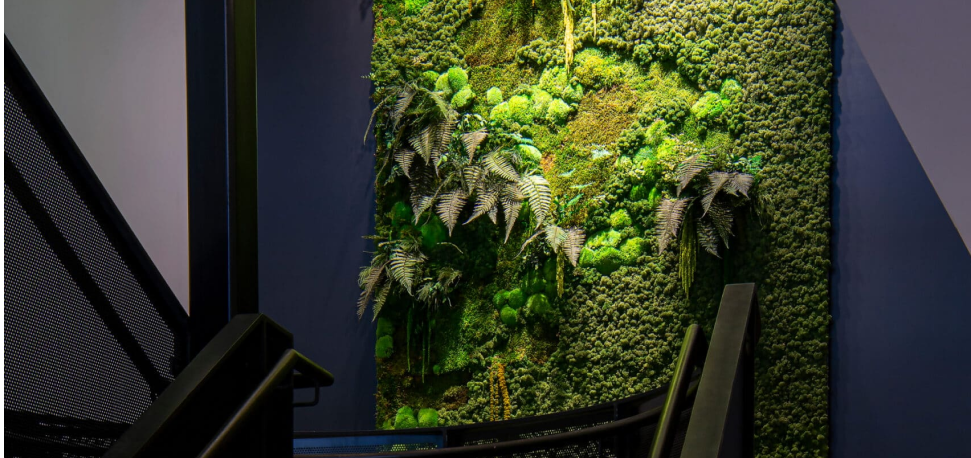
Natural Office Connections: Integrating indoor and outdoor spaces
Creating a seamless connection between indoor and outdoor spaces is an essential component of modern workplace design. This approach not only enhances the aesthetic appeal of the office but also significantly contributes to employee well-being and productivity. In New Zealand, architectural themes often focus on blending indoor and outdoor environments, whether that be the inclusion of natural materials or having natural airflow.
It certainly is ideal to capitalise on our country’s natural beauty to create inspiring and functional workspaces. As a backdrop this provides a palette of textures and colours such as wood, stone, and a colour combination that not only connects the office environment to nature but also adds varied textures that can make the space more engaging and dynamic. These materials enhance the tactile and visual appeal of the workspace, contributing to a holistic biophilic design.
Connecting indoor and outdoor spaces can provide a range of benefits, from improving air quality to enhancing mental health. Studies have shown that employees with access to outdoor views and spaces report higher levels of satisfaction and well-being. This connection to nature helps reduce stress and fosters a sense of calm and relaxation, which can improve focus and creativity.
Having the ability to connect with outside spaces can be challenging in city locations or high-rise buildings, however, the similar value is given to natural light. Our research found that employees with access to natural light and outdoor views are more likely to report higher levels of well-being and productivity. – Future Workplace Survey.
In our experience of completing workplace strategies over the past 20 years, natural light and natural air are in the top 5 consistently important features desired in the workplace. If access to natural light is challenging consider your lighting design as a key tool, thoughtfully done lighting design can mimic natural daylight, supporting circadian rhythms and enhancing the overall well-being of employees. Using a combination of ambient, task, and accent lighting helps create a balanced environment that feels natural and welcoming.
Here’s some practical application ideas
1. Greenery and Plant Life: Incorporate indoor plants and green walls to bring nature into the workspace. This can improve air quality and create a more inviting atmosphere.
2. Natural Light: Design spaces to maximise natural light through large windows. Natural light not only reduces energy consumption but also supports circadian rhythms and boosts mood.
3. Natural Materials: Use materials like wood and stone where possibly along with a colour palette that adds a tactile and visual connection to nature.
4. Outdoor Spaces: Create outdoor workspaces or terraces where employees can work or take breaks. Access to outdoor areas can provide a refreshing change of environment and a boost in creativity and well-being.
5. Courtyards and Green Spaces: Incorporate courtyards and green spaces within the office space. These areas can serve as communal spaces for socialising, meetings, or quiet reflection.
6. Texture, colour and materials: Incorporate varied textures and natural materials to create a dynamic and engaging workspace. Along with considering the psychology behind colour selection.
Contact Spaceworks – Jana Stringer, jana@spaceworks.co.nz or Bradley Keys, bradley@spaceworks.co.nz to have Spaceworks show you how these would be integrated into your business and space.





